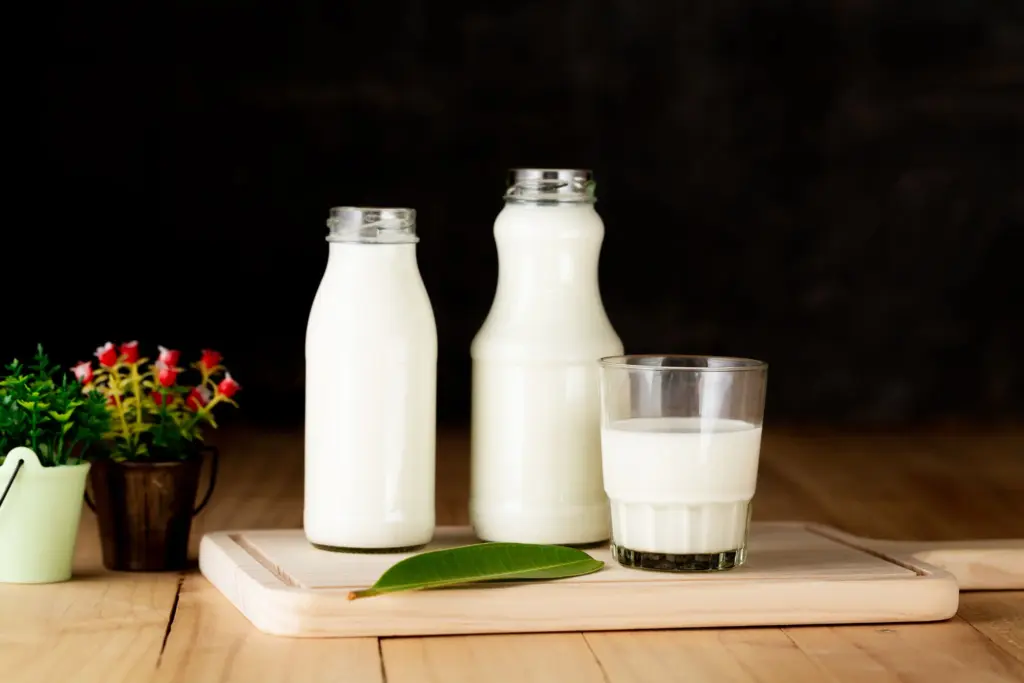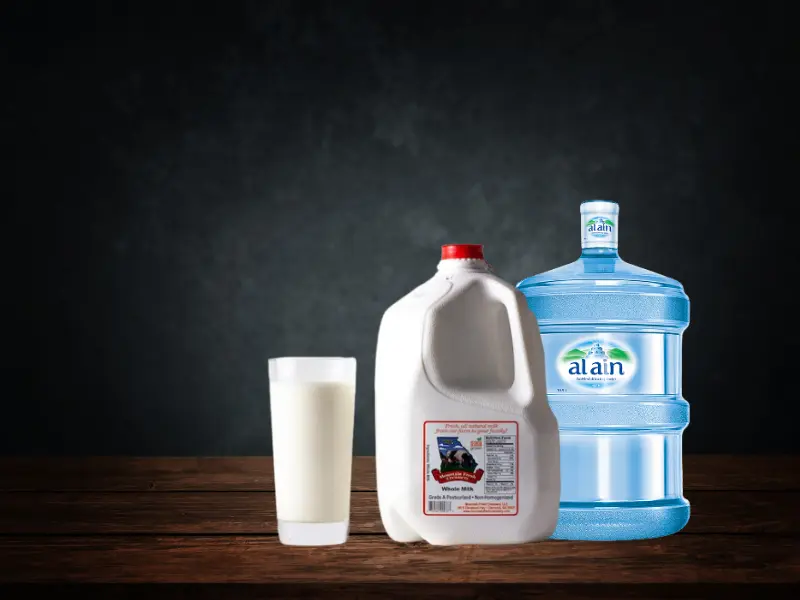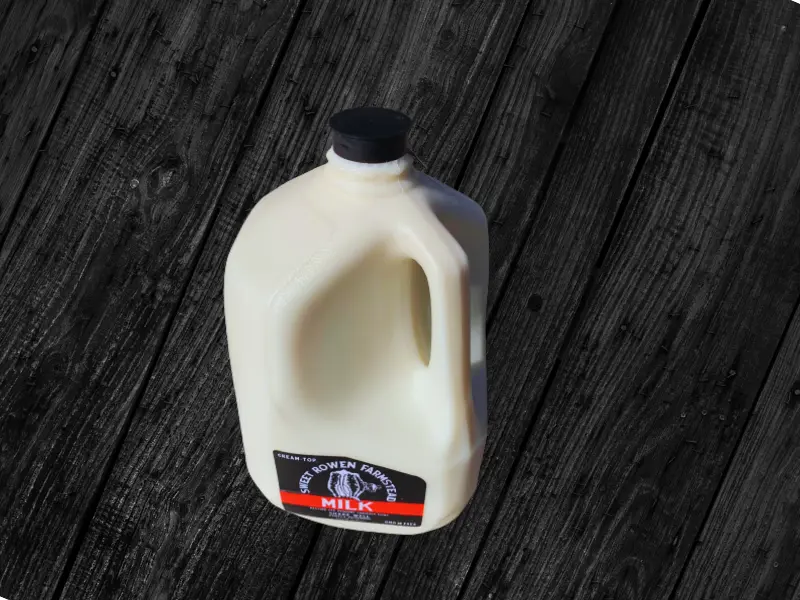Do you pay close attention to your daily calorie intake and often wonder how much a gallon of milk weighs so you can thoroughly track your food portion?
A gallon of milk weighs around 8.6 lbs or 3.9 kilograms in the US and approximately 10.32 pounds or 4.67 kilograms in UK or Canada. But this weight may vary depending on what type of milk you use and how much fat it contains per standard serving.
Below, we’ll explore how much does a gallon of milk weigh in kg, lbs, and pounds. We’ll also discuss whether all milk weighs the same, how much a gallon of milk weighs in the US, UK, or Canada, and if a gallon of water or milk is heavier.
Does all milk weigh the same?
Milk can have different weights depending on its type (whole, 2%, skim, or low-fat) and fat content, even though it might look the same. So, if the fat percentage of milk is higher, it will weigh more because fat is less dense than water.
For instance, if you compare whole milk to skim milk, you’ll notice that it weighs more per cup because of its higher fat percentage. Even when you weigh the different types of milk, such as goat, sheep, or any plant-based milk, you’ll find variations per serving.
Note: Different brands or producers might have slight variations in the weight of their milk products.
How much does a gallon of milk weigh in the US?

A gallon of milk weighs approximately 8.6 lbs or 3.9 kilograms in the US. This is the most common unit for measuring liquids in the United States, equivalent to 128 fluid ounces.
INFO: The nutritional values on a gallon of milk container in the US are usually given in grams or milligrams.
How much does a gallon of milk weigh in the UK or Canada?

In the UK and Canada, the weight of one gallon of milk differs from the US because they use the imperial gallon, which is slightly larger.
One imperial gallon of milk in the UK and Canada weighs around 10.32 pounds or 4.67 kg. But, it is essential to note that the UK does not sell milk in gallons. Instead, it is available in liters or pints.
INFO: One pint is equivalent to 0.125 US gallons or 0.47 liters.
What are the different classifications of milk?

Milk is classified into four categories based on its fat content, which affects its overall weight and nutritional profile.
1. Whole Milk
Whole milk comes from the cow and has about 3.25% more fat by weight compared to other types. An 8-ounce glass of whole milk contains around 150 calories and 13 essential nutrients.
Although it might not be the best option for those trying to lose weight or reduce their fat intake, it is an excellent source of calcium, protein, and vitamin D.
Interesting Info: You can melt Hershey’s chocolate in the microwave and mix it with milk to turn it into chocolate milk for yourself, but its nutritional value and weight will also change.
2. Reduced Fat Milk
Reduced-fat milk has a lower fat percentage, usually around 2% or less, and contains 13 essential nutrients and only 5g of fat, making it a healthier option. People often use this type of milk for cooking, baking, and as a beverage.
3. Low-Fat Milk
A standard glass of low-fat milk contains only 1% fat by weight, providing 100 calories and 2.5 grams of fat. This makes it ideal for people who watch their weight or suffer from high blood pressure or heart disease.
INFO: If you are on a strict diet that requires you to track your calorie intake strictly, you must pay close attention to how much a chicken thigh weighs.
4. Skim Milk or Fat-Free Milk
Skim milk, which contains only 0.1% fat by weight, is an excellent choice for those who want the benefits without the added fat. A standard free-fat milk glass contains 80 calories and is rich in vitamins and nutrients, like vitamins A, B12, potassium, and phosphorus.
INFO: Some other dairy and non-dairy milk types are sheep, goat, condensed, evaporated, frozen, almond, oat, soya, and coconut.
Is a gallon of water or a gallon of milk heavier?

A gallon of milk is heavier and denser than a gallon of water because it has other components like fats, proteins, lactose, minerals, and vitamins. But this value can vary depending on the type of milk you’re referring to.
For instance, cow’s milk is the most common type. But it comes in several variations such as whole, skim, condensed, evaporated, frozen, and low-fat or reduced milk, each with a different consistency and density, which might impact their weight.
However, it’s important to note that milk is mainly composed of water regardless of its type, making up around 87% of its composition. So the weight differences between various types of milk are unlikely to be significant.
How do you calculate the weight of milk?
If you want to find the weight of milk, check the container to its volume in liters, and convert it to millimeters. Then, multiply the volume in millimeters by the density of the milk to get the weight in grams. Next, multiply the value by 0.0022 to convert the weight to pounds.
Here’s the breakdown of the weight of different types of cow’s milk in one gallon:
| Type of Milk | Fat Content | Weigh in Kg | Weight in Pounds |
| Whole Milk | 3.25 % | 3.9 kg | 8.6 lbs |
| Reduced Fat Milk or 2% Milk | 2.5 % | 3.81 kg | 8.4 lbs |
| Low Fat Milk | 1 % | 4.32kg | 8.7 lbs |
| Skim Milk or Fat-Free milk | 0.1 % | 3.85 kg | 8.5 lbs |
Conclusion
In this article, we’ve discussed how much a gallon of milk weighs in the US, UK, and Canada, along with different types of milk classifications. We’ve also covered whether all milk weighs the same and is a gallon of water heavier than it.
We hope you can now confidently grab a milk gallon off the shelf and add it to your grocery cart without worrying about tracking your calorie intake.

